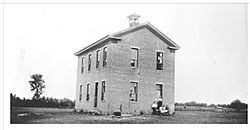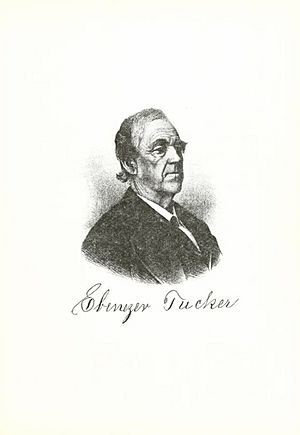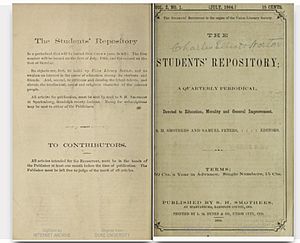Union Literary Institute facts for kids
Quick facts for kids Union Literary Institute |
|
|---|---|
 |
|
| Location | |
|
United States
|
|
| Coordinates | 40°04′38″N 84°48′59″W / 40.07722°N 84.81639°W |
| Information | |
| Type | Racially integrated |
| Established | 1846 |
| Founder | Quakers and others |
| Closed | 1880 |
| Principal | Ebenezer Tucker |
| Faculty | Ebenezer Tucker, Samuel Smothers |
| Campus size | 174 acres (70 ha) |
| Campus type | Agricultural |
| Publication | The Students' Repository |
The Union Literary Institute was a special school founded in 1846 in rural Randolph County, Indiana. It was started by Quakers and free black people from Ohio, Kentucky, and North Carolina. They created the school because, in 1843, Indiana laws said that "colored students" could not go to public schools.
When it opened, the Union Literary Institute was one of the very few schools in America where black and white students studied together. It was actually the first school of its kind in Indiana! The school briefly closed during the American Civil War, but it reopened and continued until 1880.
Contents
A Unique School for All Students
The Union Literary Institute was special because it welcomed both black and white students. This was very rare at the time. The school's leaders, called the Board of Managers, also included both black and white members. This was quite unique for the 1800s.
How Students Paid for School
The school used a system called the manual labor model. This meant that students worked on the school's farm to help pay for their education. This helped make school more affordable for many. The school also received money from donations.
The word "literary" in the school's name meant it was not a religious school. The word "Union" referred to its goal of educating black and white students together. It also served three communities of free black people nearby.
A Safe Place in Indiana
Randolph County, where the school was located, had many African American residents and white people who were against slavery. These communities were often a stop on the Underground Railroad. This was a secret network that helped enslaved people escape to freedom. Students came from places like Cincinnati, Indianapolis, and even Tennessee.
The school helped many young people get an education. It taught them important skills and helped them prepare for life.
What Students Learned
In 1864, students in the "Primary Department" learned reading, writing, math, and geography. In the "Higher Department," they studied more advanced math, English grammar, science, chemistry, and algebra.
The first teacher and principal was Ebenezer Tucker. He was a white man who had studied at other schools that supported equal education. He led the school for many years.
The school owned a large farm of 174 acres. It had a boarding house for 40 students and a school building for 100 students. The cost for students, besides their work, was about $20 to $30 per year. The school taught about 300 black students over the years. Many of them became teachers themselves.
The School's Legacy
After the American Civil War, many black families moved away from the area. The school eventually closed in 1880. The building later became a public school, but it was segregated, meaning black and white students were taught separately. The school building closed completely in 1914 and was used as a barn for a long time.
In 2016, a historical marker was put up at the site. It reminds people that the Union Literary Institute was one of the first schools to offer higher education to all, no matter their race or gender, before the Civil War. It also highlights that the school was a known stop on the Underground Railroad.
The Students' Repository Magazine
From 1863 to 1864, the school published a magazine called The Students' Repository. It was a quarterly magazine, meaning it came out every three months. It focused on education, good behavior, and general improvement. About 1,000 copies of each issue were printed.
The magazine even got mentions in famous publications like Harper's Magazine and the North American Review. The magazine stopped when its editor and teacher, Samuel H. Smothers, joined the Army during the Civil War.
The magazine included articles like "Uncle Abram," which was a report about an enslaved person who was treated very badly. It also featured writings by famous people like Charles Eliot Norton.
Notable People Who Attended
Many important people attended the Union Literary Institute:
- Hiram Rhodes Revels: He became the first African-American U.S. senator.
- Amanda Way: She was a leader in the Indiana Women's Suffrage movement, which fought for women's right to vote.
- James Sidney Hinton: He was the first black person elected to the Indiana House of Representatives.
Historical Records
The William Henry Smith Memorial Library in Indianapolis keeps important historical records from the Union Literary Institute. These records include the school's meeting notes from 1845 to 1890.



